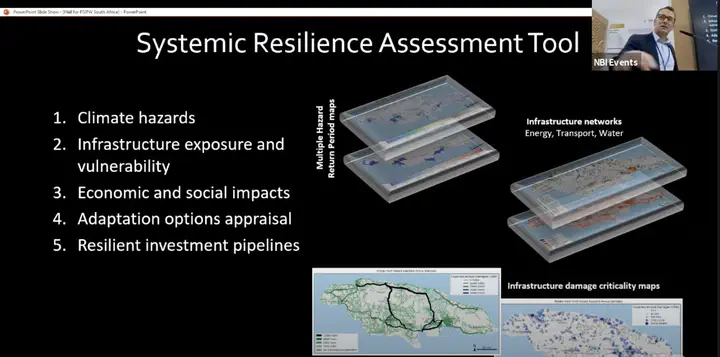COP26 | OPSIS tools make case for adaptation investment for long-term infrastructure financing decisions

The OPSIS Systemic Resilience Assessment Tool creates a ranked set of investment opportunities for improved decision-making for long-term infrastructure decisions. Professor Jim Hall spoke on ‘Physical climate risk analytics to inform adaptation-aligned finance’ at COP26, representing the Prince Sultan Bin Abdulaziz International Prize for Water. His talk focused on the OPSIS group expertise on climate hazards and systemic resilience, to identifying infrastructure exposure and vulnerabilities and their economic and social impacts.
Professor Hall highlighted the risks of climate change to infrastructure sectors (transport, energy and water) and the interdependencies between them. He also emphasised how those risks are becoming increasingly relevant from an investment perspective because of the movement towards financial disclosure of climate risks and how analysis is developing in order to provide investors with information about those physical climate risks in order to incentivise resilience to ensure that investments in infrastructure in the future are resilient to climate change, as well as incentivising financial investments in adaptation which is so greatly needed.
The scale of the adaptation deficit from the UN Environment Programme shows a need of USD 70 billion in developing countries currently, expected to rise to USD 140-300 billion in 2030 given the climatic extremes we are facing. However, investment is currently not rising in line with needs. Climate and mitigation and adaptation investment is now generally being committed to on a 50/50 split, representing a more significant percentage going to adaptation than in the past. Making the case for adaptation investment can be difficult and needs a proper understanding of the scale of physical climate risks and how investment in adaptation reduces those risks and makes propositions more investable is essential in order to mobilise finance.
The greatest percentage of adaptation finance currently goes into water and wastewater management, with just 7% of that going into infrastructure however water is a category of infrastructure, and the two percentages together represent 39%, representing essential services to society with long lived assets and which will have to survive in a future climate with very different conditions from today.
Bridging the adaptation finance gap requires much more credible project preparation for adaptation projects – the finance community requires readily bankable projects and demonstrations of risk reduction benefits of adaptation which meet financing requirements to quantifiably reduce climate risks. This information can then be used to prioritise where those adaptation investments ought to go.
The OPSIS research group quantifies and maps physical climate risks to infrastructure, identifies options for climate risk management, from strengthening and maintenance to nature-based solutions and at a systemic and network level. The OPSIS Systemic Resilience Assessment Tool creates a ranked set of investment opportunities for improved decision-making for long-term infrastructure decisions.
Watch the video below (Professor Hall from 21 mins):